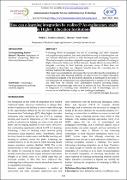How can e-learning integration be realized? An exploratory study in higher education institutions

View/
Date
2013Author
Tusubira, Philper I.
Mayoka Kituyi, Geoffrey
Nyeko, Sonny
Metadata
Show full item recordAbstract
E-learning, which encompasses the use of technology and other computer enhanced learning methods, has been identified one way of delivering low cost and efficient education service in both developed and developing countries. These technologies have been adapted to support other methods of teaching in Higher Education Institutions (HEIs). However, despite efforts by many HEIs to integrate e-learning in their teaching processes, many of them have not succeeded or they have not obtained benefits from the e-learning due to barriers that limit the integration process. This study was conducted to investigate the factors affecting the integration of e-learning with other teaching methods. To achieve this, five Higher Education Institutions in Uganda were purposively identified to participate in the study. A self-administered questionnaire was administered to a sample of 341 students and staff from the selected HEIs. Quantitative statistics including means, frequencies and percentages were used to analyze the data. The main barriers to integration of e-learning were identified as lack of knowledge, lack of resources and staff failure to adapt to new teaching technologies.
